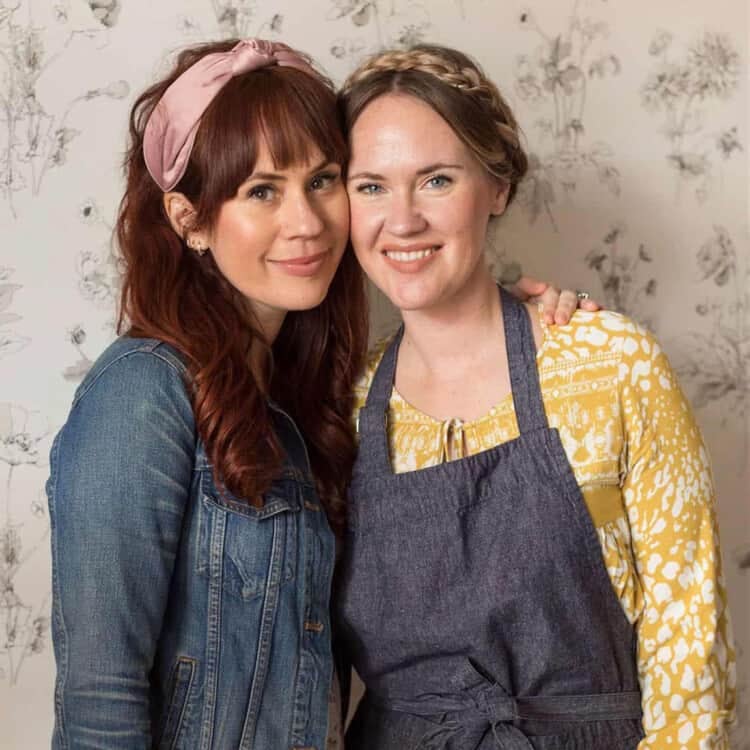We are so excited to welcome two of our favorite baristas, Jason Strother and Isaac Neale, to share how to brew coffee in a Chemex. Jason and Isaac are co owners of Kingdom Coffee, one of our very favorite coffee spots in Springfield, MO.
Personally, Chemex coffee is my favorite way to make coffee in the morning. My husband and I have been making our morning coffee in a Chemex for probably 6+ years now. It’s quick, easy, and IMO makes the best coffee.
Related: How to Brew Coffee in an Aeropress, How to Make Cold Brew Coffee, and How to Make French Press Coffee.
Chemex is our favorite multi-cup brew method. Chemex filters are 20-30% heavier (more absorbent) to remove undesirable sediment particles and oils, producing a cleaner, sweeter cup of coffee.
The main drawback of using a Chemex is that it is not great for making a single cup of coffee unless you buy the single serving (3-cup) size Chemex
Chemex requires an overall brew time of approximately 6 minutes. Coffee should be ground medium-fine. On a scale of 1 to 10, with 1 being the finest and 10 being the most coarse, this grind would be a 7 or 8.
The more coffee you are brewing at a time, the coarser it should be. For this particular set of parameters, it will be closer to 11.
Chemex Coffee Supplies
-Coffee: You’ll need 42g of your favorite medium to light roast coffee.
-Grinder: We are using a Hario Slim Hand Mill. This is a burr grinder, which produces much more consistent granules than a blade grinder, which is really better suited for grinding spices.
-Scale: We are using the AWS (American Weight Systems) SC-2kg scale. To consistently produce good coffee, it is imperative to measure all of your ingredients.
-Kettle: We are using a Bonavita 1 Liter Electric Gooseneck Kettle. This kettle is very easy to use. You simply need to fill it, switch it on, and it will kick off automatically when it reaches temperature.
-Chemex + filters: We are using the 6-cup Chemex, but these parameters will work with the 6, 8, or 10 cup Chemex. We prefer the bleached filters because they give a cleaner, truer extraction, imparting less papery taste to the coffee
-Coffee cups: Any mugs will do, but make sure you preheat them by filling them halfway full with brew-temperature water to avoid thermal loss to the coffee.
-Timer (or iPhone): Anything that counts in seconds will work fine. Pro tip: You do not need to stop and restart the timer during extraction; you can let it run continuously using a bit of addition.

How to Use a Chemex
Step One: The Preparation. Weigh out your coffee (42g) and start heating your water. We are using a brew ratio of 1:15 grams (i.e., 1 gram of coffee to 15 grams of water), so you will need 630 grams of water for brewing and allow for 300 grams to rinse and preheat your vessels.
You can go ahead and grind your coffee while you’re waiting for your water to reach temperature.
Step Two: The Filter. Open the filter and place it in the Chemex with the layered side toward the spout. Rinse the filter with brew-temperature water.
Now, add your coffee to the rinsed filter. This will help the filter to hold its shape as you remove it to pour out the rinse water. Once finished, place the filter back in the Chemex.
Step Three: The bloom. Wet the grounds with 80-100 grams of water (about twice as much water as coffee grounds) and wait 45 to 60 seconds (depending on the age of your coffee).
You should see some bubbles emerge from the grounds. This is trapped gas escaping the coffee, which will allow for a more even extraction. If you don’t see any, this might indicate that your coffee is old.
Step Four: The Pour. You will now pour the remaining water (for a total of 630 grams of water) in a circular motion in the center of the grounds.
Try to constrain your pour to the area of a half dollar. Avoid pouring water toward the edges, as the water will run down the outside of the Chemex wall without extracting the coffee properly.
Step Five: The Finish. Once the stream of coffee exiting the filter slows to a drip, you can remove the filter, grounds and all, and dispose of it (we recommend tossing on your compost pile).
Now you are ready to serve and enjoy! And if you enjoy pretty coffee photos, you can follow Kingdom on Instagram @kingdom_sgf.
More Coffee Recipes
Get our FREE recipe guide with our most popular recipes of all time!

Free Popular Recipe Guide
Our top 25 recipes of all time!
 Get the Recipe
Get the Recipe
Ingredients
- 42 grams coffee
- 630 grams water
Equipment
- Chemex
- Chemex filters
- Gooseneck kettle
Instructions
- The Preparation. Weigh out your coffee (42g) and start heating your water. We are using a brew ratio of 1:15 grams (i.e., 1 gram of coffee to 15 grams of water), so you will need 630 grams of water for brewing and allow for 300 grams to rinse and preheat your vessels.
- The Filter. Open the filter and place it in the Chemex with the layered side toward the spout. Rinse the filter with brew-temperature water.
- Now, add your coffee to the rinsed filter. This will help the filter to hold its shape as you remove it to pour out the rinse water. Once finished, place the filter back in the Chemex.
- The bloom. Wet the grounds with 80-100 grams of water (about twice as much water as coffee grounds) and wait 45 to 60 seconds (depending on the age of your coffee). You should see some bubbles emerge from the grounds. This is trapped gas escaping the coffee, which will allow for a more even extraction. If you don’t see any, this might indicate that your coffee is old.
- The Pour. You will now pour the remaining water (for a total of 630 grams of water) in a circular motion in the center of the grounds. Try to constrain your pour to the area of a half dollar. Avoid pouring water toward the edges, as the water will run down the outside of the Chemex wall without extracting the coffee properly.
- The Finish. Once the stream of coffee exiting the filter slows to a drip, you can remove the filter, grounds and all, and dispose of it (we recommend tossing on your compost pile).
Notes
- Chemex is our favorite multi-cup brew method. Chemex filters are 20-30% heavier (more absorbent) to remove undesirable sediment particles and oils, producing a cleaner, sweeter cup of coffee.
- The main drawback of using a Chemex is that it is not great for making a single cup of coffee unless you buy the single serving (3-cup) size Chemex.
- Chemex requires an overall brew time of approximately 6 minutes. Coffee should be ground medium-fine. On a scale of 1 to 10, with 1 being the finest and 10 being the most coarse, this grind would be a 7 or 8.

I discovered that bending the end of a spring and hanging it down the pour spout channel will do away with the vapor/steam lock that usually plagues these Chemex coffee makers–slowing them to a crawl.
The Chemex coffee makers are amazing. I always hated having the sediment of the coffee in my cup when making it with a french press coffee maker. But with the Chemex, this doesn’t happen anymore. The filter is designed to prevent bitterness and to avoid any sediment to drip into the coffee; simultaneously used with the non-porous glass, the beverage comes out clear, pure and flavorful. I simply love my new Chemex!
Kind regards from another Chemex lover 🙂
I LOVE my Chemex! I got it for xmas last year and my mom kept complaining “I don’t get it, how do you keep the coffee warm enough to last all morning?” Um. Mom. You don’t! Argh!
How many clicks are you using on the Hario grinder (mini mill I’m guessing?) from closed?
great tutorial Kingdom coffee! As a fellow barista, i’m curious: What’s the total brew time with these parameters?
We have the wooden Chemex 6 cup and use it with a stainless steel Coava Kone filter and it has been amazing for the last 4 years.
I worked as a barista all through college, but we never used Chemex, only French Press, so that’s what I’m familiar with. Thanks for sharing all the details about this — I have seen it growing in popularity but now I feel a little more educated!
Best Coffee people ever!
I’ve never even heard of a Chemex! Thanks for the tutorial and the intro, though, can’t wait to check it out.
PS: Love the music for the video!
Kerrie,
Yes, that’s correct. You will need to preheat around 930 grams of water total.
I would have liked to seen the inside of the carafe during the poor.
Ashley! Well funny you should ask… I would keep checking back if I were you! 😉 xo-Sarah
I feel like I can smell that coffee just looking at it! Yum!!
so glad you all made a video! I’ve seen many tutorials for this type of brewing but there are so many steps that it can get confusing. Also, I love that you all are bringing in local and distant craftsmen onto the blog, allowing for a diverse amount of content!
Love where this blog is heading 🙂
This is a great tutorial — any chance you’ll do one for the AeroPress?
I hear the chemex makes awesome coffee! I have yet to try it out though, but hopefully I’ll get the chance soon!
xoxo
Taylor
Thank you for sharing this! I’ve been meaning to get a Chemex for my office since I’m not always able to run and get coffee before work–and, let’s be honest, it gets pretty expensive to buy coffee every day. I can’t wait to try this out!
-Helen Grace
http://www.sweethelengrace.com
Great idea, coffee is such an interesting product!
Thanks for the refresher! I am going to get the scale out and check my measurements this afternoon. I brew with this method most of the time now although I use a Cilio ceramic filter holder. I like the Cilio because it works great for making one cup at a time. It holds #4 filters which we have for our Bonavita coffee machine, and bonus…the Cilio costs something like half of what a Chemex does (so I bought two).
ha! looks like a science experiment!! Never even heard of this method of brewing before…so cool!